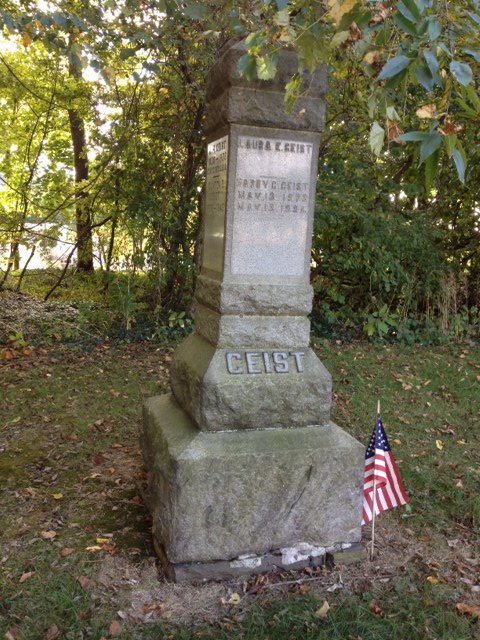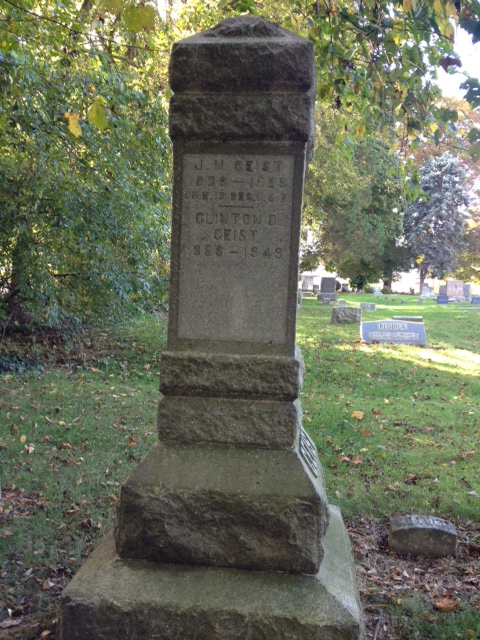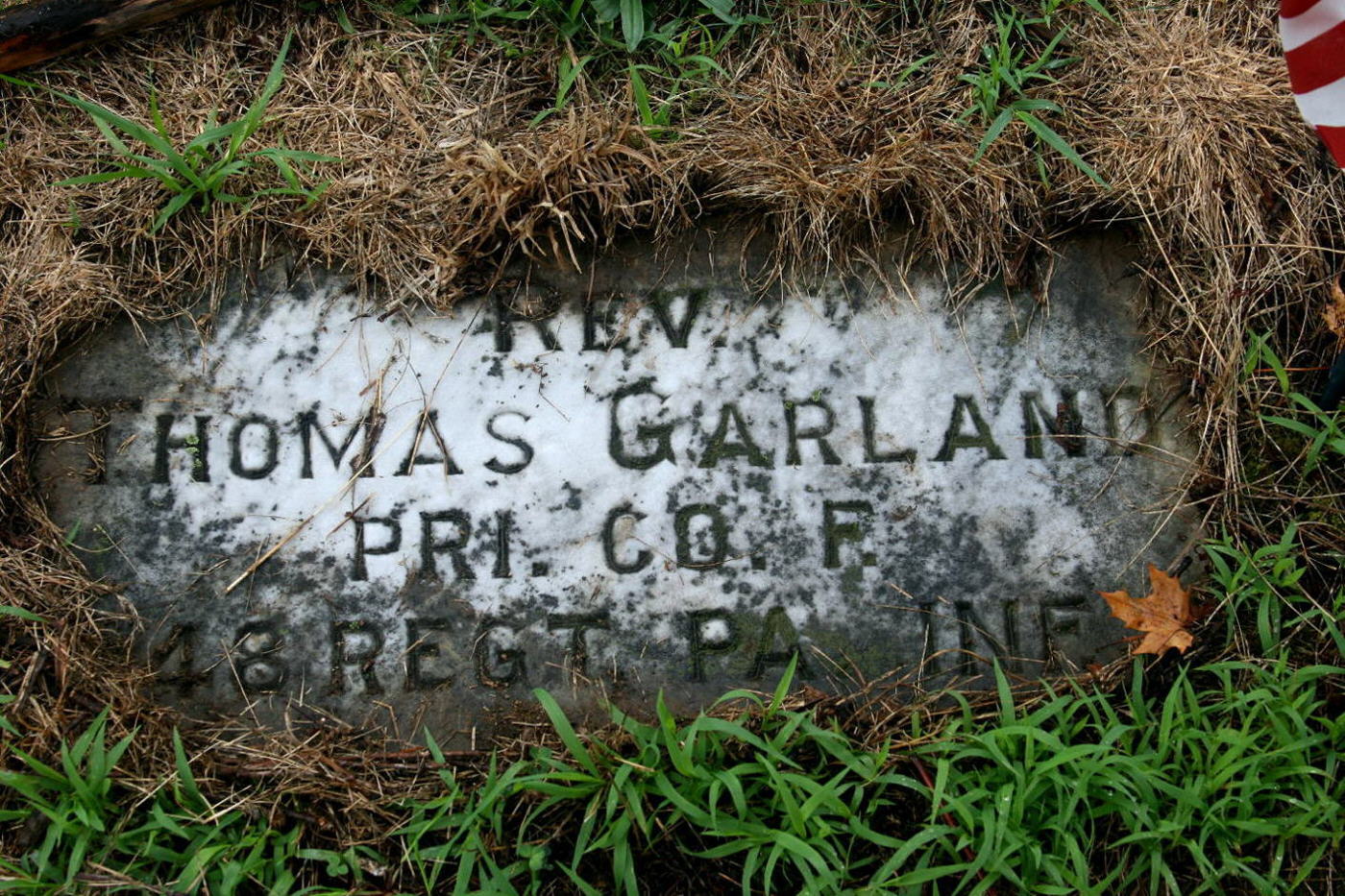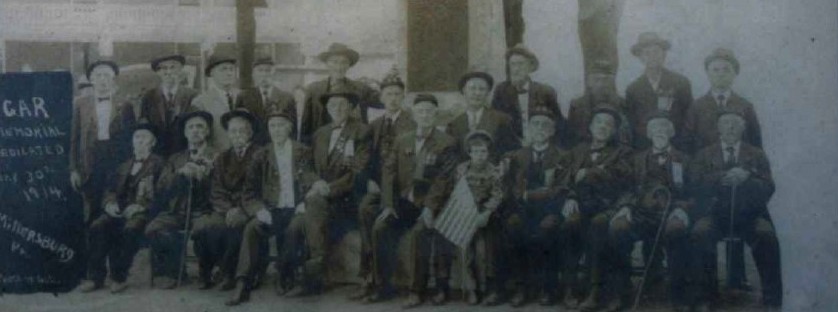Posted By Norman Gasbarro on January 2, 2016

The Virginius
This is another story about Simon Gratz (1842-1923), the son of Theodore Gratz (first mayor of Gratz, Pennsylvania), and the grandson of the Simon Gratz who is credited with laying out the town of Gratz and for whom the borough is presently named. Although Simon Gratz was born in Harrisburg, the family moved to Gratz, where he spent part of his youth, including attending school, before the family returned to Harrisburg where his father Theodore died in 1863.
Perhaps this is a tall tale, invented by Simon Gratz for self-promotion in the years after the Civil War. Perhaps not. There are some elements of truth to it just as there are elements of truth to the Spy Capture Incident of South Harrisburg, also purportedly involving Simon Gratz, described here in a prior blog post.
About two years prior to the Spanish-American War (24 June 1896), a first-hand account appeared in the Harrisburg Telegraph of an earlier 1873 effort to free the island of Cuba of Spanish rule. The Virginius, once a Confederate warship, but captured by the Union at the end of the Civil War, was sold in 1870 to a private individual, and registered in New York. It became part of a plan to transport men and munitions to assist Cuban rebels then fighting to free the island of Spanish rule. For this purpose, the ship was secretly protected by two American warships, and therefore was somewhat successful. The Spanish, who thought it an “outlaw ship,” tried to capture it, and in 1873 succeeded. There were so-called trials of 53 of the men aboard, many of them Americans or English, who were executed as pirates at Santiago, Cuba. This resulted in some diplomatic maneuverings between the Grant Administration in Washington and the government in Spain. Eventually, the matter was settled by negotiation and an indemnity was paid to the families of those Americans who were executed. In The Diplomatic History of the American People, Thomas Bailey states: “More would have perished had not Captain Lorraine, of the British warship Niobe, arrived in haste and trained his guns on the city.” [p. 381].
Thus, in 1896, Simon Gratz, who claimed to be the only survivor of this incident, told his account as follows:

A Virginius Survivor
There is a man in this city [Harrisburg] who was led out to die by the Spaniards in Cuba, twenty-five years ago, and in Santiago, too, where the big fighting is going on to-day. His name is Simon Gratz, and there are many in this city who know him, but do not know that he is the only survivor of the famous Virginius crew of filibusters what went to Cuba in 1873 for the purpose of freeing that unhappy island….
The only survivor of the crew of fifty-four of the ill-fated steamer Virginius lives in Philadelphia. He is Simon Gratz…. Gratz has followed a military life since boyhood, and at the conclusion of the Civil War had won his rank as Captain….
After the war he was detailed for service in the West and was mustered out 13 December 1866. Coming back to Pennsylvania, he chanced to attend a Cuban meeting at the Academy of Music [Philadelphia]. There he heard addresses made by Judge Kelley, then Congressman, and A. K. McClure. Not having enough of war, and moved by the words of the speakers, he determined to go to Cuba. At first he was unsuccessful.
His second attempt was in 1869, on the Cuban yacht Anna. This voyage was more successful. He landed in Cuba in the Canmoway District, south of the old trocha near Matanzas. The yacht brought 1500 stands of small arms, 250 machetes, five tons of ammunition, and two twelve-pounders for General Jordan, formerly Chief of Staff of the Confederate General Beauregard, who forthwith, defeated the Spanish General Pollio. Gratz was in the engagement.
On the island he was surprised to find espousing the Cuban cause many familiar American faces and many prominent personages of the Civil War. Among them was the ex-consul to Cuba, Frederico Caveda, who threw up his consulship to take up the arms of his country; also his brother, Adolpho Caveda; General Ryan, the famous Western scout in the Union Army; Colonel Bernard and others. He entered the Cuban Army as a Captain and served for a year and a month.
His work there was interrupted by a letter from home, urging him to come to Philadelphia to settle up some private affairs. His resignation was not accepted by his Cuban leader, Caveda, but he was detailed to New York and Philadelphia to do what he could for the cause at home.
This was in the year 1873, and about the time when the ill-fated and now historic steamship Virginius was fitting out. Captain Gratz again applied to the Cuban Junta and once more sailed for the island from New York on the Atlas, which was carrying an expedition of 100 men. The Atlas met the Virginius at Kingston, Jamaica. All un-suspicious of the terrible fate in store for them the entire party went aboard the big side-wheeler and steamed to Port-au-Prince, Haiti. The Virginius had been searched at Jamaica by the English authorities and nothing but coal was found in her hold. She was again searched at Port-au-Prince and found empty save her engine supplies. The she turned toward the Cuban shore.
She was an old boat and her bow-plate had parted. In spite of all they could do the water gained and put out the fires. The big boat was helpless. The Spanish warship came up within range and immediately opened fire. To save the lives of his men Captain Fry surrendered.
The Spanish crew came aboard and searched the vessel. There was nothing in her hold. In spite of that fact the vessel was taken to Santiago de Cuba, the nearest port. the passengers being placed in iron on the Spanish warship, the crew being kept on board to work the boat.
What happened in history. It is well-known how the Spaniards, after a mock trial by court-martial, executed General Ryan, General Nembetta Varona, Jesus del Solano Cespedes, a brother of the President of the Cuban Republic, the four leaders of the expedition. There were 155 passengers and crew on board the Virginius. The naval court-martial tried the crew, which consisted of fifty-two men, and condemned thirty-seven of them to be shot. The army court-martial tried the 116 passengers and condemned seventeen of them. Gratz was one of the seventeen.
History states that fifty-three were executed, but according to the above statements fifty-four were condemned. This is the story of how Gratz, the fifty-fourth man, escaped.
The men were executed in sections. First, as stated, the four leaders were shot, then the ship’s crew, thirty-seven at once. The horror of that day, when these brave and innocent sailors were led out and stood in a row in front of a line of guns in the hands of the murderous Spaniards, was fearful; but what it must have been to Gratz, who witnessed the execution from the narrow window of a Spanish cell, knowing, as he did, that possibly on the morrow he would stand in their place and, like them, be thrown for dead in a pit. His body, too, would be trampled down by the horses of the cavalry in order to pack the dead men so that the ground would not shop the place where they rested.
Hardly were the bodies of the last thirty-seven of the sailors cold when the cell door was thrown open and Gratz and the rest of the passengers were ordered to come out. It was their turn next. According to the custom of that country, Mass is offered to all those who wish it when they are about to die. The condemned men were led into a chapel and the services begun. After it had proceeded for a while one of the priests discovered that there were thirteen of the doomed number. Out of the seventeen condemned the four officers had already been shot. True to the superstition concerning that number originating in the priest’s mind from the thirteen at the Last Supper, the young priest refused to proceed with the ceremony unless one more was added to the number. Unfortunately for the Spaniards, they did not have any more, and it became necessary to take one away.
Among the Spanish officers was a certain Captain O’Callahan, who had formerly been a Confederate officer and had afterwards entered the Spanish service. He had tried to save the life of the American scout, General Ryan, but failed. When this superstitious dispute arose about the number thirteen he saw an opportunity to save an American’s life and interceded for Simon Gratz. He was the only one of the thirteen who was an American. The Spaniards did not know that the man was the famous Cuban Captain Gratz. His name on the passenger book appeared as Samuel Gray. They commuted his sentence for forty-eight hours and he was taken to his cell. His companions were shot. He alone was left.
That night the English man-of-war Neyoba, commanded by Captain Sir Rowan, came into the harbor and dropped anchor. The English Consul informed him of the terrible slaughter, He forth-with went to the Spanish Governor-General Burriel and forbade any more shootings in the name of humanity, adding that if he were disobeyed the English guns on the man-of-war would open fire on the town.
He was not disobeyed. The rest of the un-condemned men – one hundred and one of them – together with the condemned Gratz, were smuggled out of the town prison into the fortified Morro Castle at the entrance of the bay and there thrown into the dungeon, Two of the unfortunates, both Englishmen, went insane. Twenty days later, in answer to the demand of the United States, the remainder were sent back to America on the steamer Juniata, commanded by the late Commander Brain.
Over the years following this 1873 incident, this story played out in the press in Harrisburg, and took some strange twists – as well as the reputation of Simon Gratz being enhanced. No press stories of Simon Gratz and this Cuban affair have been found from 1873, but that does not mean they do not exist.
Readers of the Harrisburg Telegraph, 25 January 1878, may have seen the following brief mention of a rumored connection between Simon Gratz and Cuba:
We learn from Captain Gratz there is no truth in the rumor that he is about to join a Cuban expedition. He cannot account for its origination.
Then, on 25 February 1880, the Harrisburg Telegraph reported the following on Captain Gratz being summoned as a witness in a New York libel trial:
A Harrisburger Summoned in a Libel Suit Against the New York Herald
Francis L. Norton was a captain of a Cuban vessel in the interest of the Revolutionists and Republicans of the Island, who were represented by a committee in New York, and during his cruising off the coast of that island run into a port where he was captured. The New York Herald charged that Captain Norton did this purposely, for which the Captain sued the proprietor of that paper for libel.
The Herald correspondent has written to Simon Gratz, of this city, summoning him as a witness in the case. Mr. Gratz has had great experience in Cuban affairs, having been one of the crew of the Virginius, captured some years ago, a number of his companions having been shot, while he escaped by a miracle. His knowledge of the Cuban Revolutionists is very extensive, and his testimony in the case will be of importance.
But, in the Harrisburg Telegraph of 24 June 1896, the same day that paper published the extensive account of Simon Gratz‘ escape from Cuba as a result of being number thirteen of the group, gave a slightly different account noting that Gratz was not the only Harrisburger who was involved in 1873:
When you talk of Cuban filibustering expeditions you must not forget the one in which two Harrisburgers figured — that of the Virginius in 1868 [sic]. The war in Cuba was fairly on, and it looked as if the Cubans fighting for their freedom would certainly win. An expedition was fitted out in this country by some daring spirits, and among those who joined was Albert Wyeth and Simon Gratz of this city. They had both been in the army, Gratz as a member of the City Zouaves, or Company A, 127th Regiment [127th Pennsylvania Infantry], and Wyeth as a musician. These Americans started for Cuba on the ship Virginius, and when near the Cuban coast the ship was captured by a Spanish warship and the whole party thrown into one of those Cuban dungeons that are a disgrace to civilization. Of course there was no excuse for these men going on the expedition, and they had no right to kick about their treatment, but they certainly had a tough time of it. One day the Spanish would lead them out to the adobe wall to be shot, place them with their faces to the wall, pretend they were going to shoot, and the, after frightening the poor fellows half to death, they would order them back to the dungeon. The Spanish were only playing with them — having fun with them, so to speak. But they were not all treated that way. Some of them, including Captain Fry, the leader of the expedition, were shot shortly after being captured. Only the intervention of the English Consul and the appearance of an English man-of-war, which was subsequently joined by an American man-of-war, saved the others from being shot. Wyeth was one of those who was executed, but Simon Gratz lived to return home and relate the horrors he had passed through. Mr. Gratz was led out five times to be shot, and had given up all hope when rescue came.
Then there was general silence from the Harrisburg newspapers, until Simon Gratz decided in 1905 that he would try to seek compensation from the Cuban government, now free of Spanish rule as a result of the Spanish-American War, for his earlier role in helping to support the Revolutionists. From the Harrisburg Telegraph of 13 March 1905:

Survivor of “Virginius” Seeks Pay for Services
Capt. Simon Gratz, of This City, Thinks Cuba Ought to Recompense Him for His Efforts to Free That Island in 1873
Captain Simon Gratz, a former resident of this city, one of the ill-fated party on the Virginius, which set out to free Cuba in 1873, the expedition sailing from Jamaica in November of that year, is about to put in a claim against the Cuban government for services in the struggles for Cuban freedom.
Captain Gratz at the time was a resident of Harrisburg, and when the Civil War broke out he enlisted as a member of Captain Henry McCormick‘s Lochiel Grays. He afterward served in the war as an officer and was mustered out as a Captain, after gallant and meritorious service.
After the war he was much interested in the freedom for Cuba and enlisted a company in Philadelphia which got to the Cuban coast but did not do much as the yellow fever broke out among them and the company was rescued by a United States steamer. Captain Gratz returned to New York and got another company together, which saw service in Cuba.
It was in 1873 that he joined the Virginius crew at Jamaica and the party set sail to save Cuba. On the high seas the Virginius was caught by a Spanish war vessel, the ship towed into the harbor at Santiago, and there from day to day parties of the prisoners were taken to shore, lined up against a wall, blindfolded and shot.
It was while the Spaniards were doing this wholesale execution that a British war vessel hove in view, followed by a United States vessel, and the slaughter was stopped.
Among the prisoners who were rescued by [sic] Captain Gratz, but it was through no wish of the Spaniards that he got away, as they were particularly anxious to kill him. Fortunately he had shipped as Simon Gray, and they did not recognize him.
Afterward, Captain Gratz came back to this country and for a while lived in Harrisburg. For the past twelve years he has been a street car conductor in Philadelphia. His application for compensation for services is accompanied by official and duly certified statements involving all of the detail setting forth his services, and it is through that at last he will receive the reward from the Cuban government that he so well deserves.
Among those on the Virginius who were lined up against the wall and show was Albert Wyeth, a young Harrisburg drug clerk, who had served in the United States Army.
In 1909, a letter was sent to the Harrisburg Daily News [published, 14 November 1909] responding to the whereabouts of Simon Gratz, “E.G.G.”, reported the following:
Al G. Wyeth, a youth wholly inexperienced in army life, was on his way to serve the Cubans as a telegraph operator, became separated from the Upton Expedition, was captured by the Spaniards, was tried and summarily executed.
Mr. Simon Gratz is the only surviving Cuban Army officer of the ill-fated Virginius expedition and is in the employ of the City of Philadelphia, City Hall, Philadelphia, Room 796.
Nothing was mentioned by the writer of the letter indicating whether or not Simon Gratz had received the pension he applied for in 1905. But on 17 November 1917, the Harrisburg Evening News reported that the pension was finally granted:
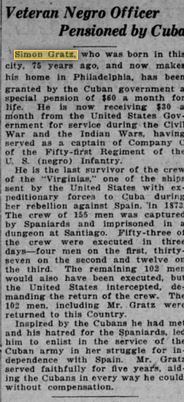
Veteran Negro Officer Pensioned by Cuba
Simon Gratz, who was born in this city, 75 years ago, and now makes his home in Philadelphia, has been granted by the Cuban government a special pension of $60 a month for life. He is now receiving $30 a month from the United States Government for service during the Civil War and the Indian Wars, having served as a Captain of Company C of the Fifty-First Regiment of the U. S. (Negro) Infantry [51st United States Colored Troops].
He is the last survivor of the crew of the Virginius, one of the ships sent by the United States with expeditionary forces to Cuba during her rebellion against Spain in 1873. The crew of 155 men was captured by Spaniards and imprisoned in a dungeon in Santiago. Fifty-three of the crew were executed in three days — four men on the first, thirty-seven on the second, and twelve on the third. The remaining 102 men would also have been executed, but the United States intercepted, demanding the return of the crew. The 102 men, including Mr. Gratz, were returned to this country.
Inspired by the Cubans he had met and his hatred for the Spaniards, led him to enlist in the service of the Cuban Army in her struggle for independence with Spain. Mr. Gratz served faithfully for five years, aiding the Cubans in every way he could without compensation.
When Simon Gratz visited Harrisburg in 1920, the Harrisburg Evening News of 11 August 1920, told of his visit as follows:
ONLY U.S. CITIZEN TO HOLD CUBAN PENSION
Captain Simon Gratz, of Philadelphia, formerly of this city, the only citizen in the United States who receives a pension from the Cuban government, is spending several days in Harrisburg visiting old friends. The pension was awarded Captain Gratz in recognition of his services in the War for Cuban Independence in 1868, when he took part in many battles under General Frederico Cabada. Gratz was born in this city in 1842.

Click on document to enlarge
Simon Gratz died on 1 June 1923 in Philadelphia. His death certificate, shown above from Ancestry.com, notes his parents as Theodore Gratz and Ellen Carson, and his birth date as 22 February 1842, thus confirming that this is the same Simon Gratz who lived for a time during his youth in Gratz Borough. He is buried at Northwood Cemetery in Philadelphia, but as of this writing a Findagrave Memorial has not been created for him. The information in the death certificate refers to his marital status as “widowed.”
The story of the escapades of Simon Gratz in Cuba has mutated several times over the years and needs fact checking. Did he play as much of a role as he claimed he did in the struggle for Cuban independence? There are many interesting facets, which if true, could be the basis for much further study. Certainly, the story of his delayed execution due to him being number thirteen with its analogy to the Last Supper, is one of the most ironic, especially considering the Jewish roots of his family.
Comments are invited from readers, especially those who can either debunk or support parts of the narrative given above.
————————————-
News clippings are from Newspapers.com. For additional information about the Virginius Affair, see: The Spanish American War Centennial Website.
————————————-
Addendum:
The following information was provided by research contributor Steve Williams via e-mail on 7 January 2016:
I found a lot of articles in New York newspapers [from 1873 and 1874] that mention [Simon Gratz]… as one of the captured crew. The 29 December 1873 New York Herald has an account by Gratz of his captivity… [but] I was only able to find an image of one page of the article. Gratz’s account is actually on the opposing page but shows up in the scan partially cut off. [I also found an article entitled, “Gratz Refuses to Make Statement to DA About Virginius“]. You can search and read all the… articles at the Old Fulton Post Cards website, http://fultonhistory.com/Fulton.html. The search terms that I used were “Gratz” and “Virginius.”
Category: Research, Stories |
Comments Off on Simon Gratz and the Virginius Affair
Tags: African American, Gratz Borough, Gratz family, Jewish
 ;
;
